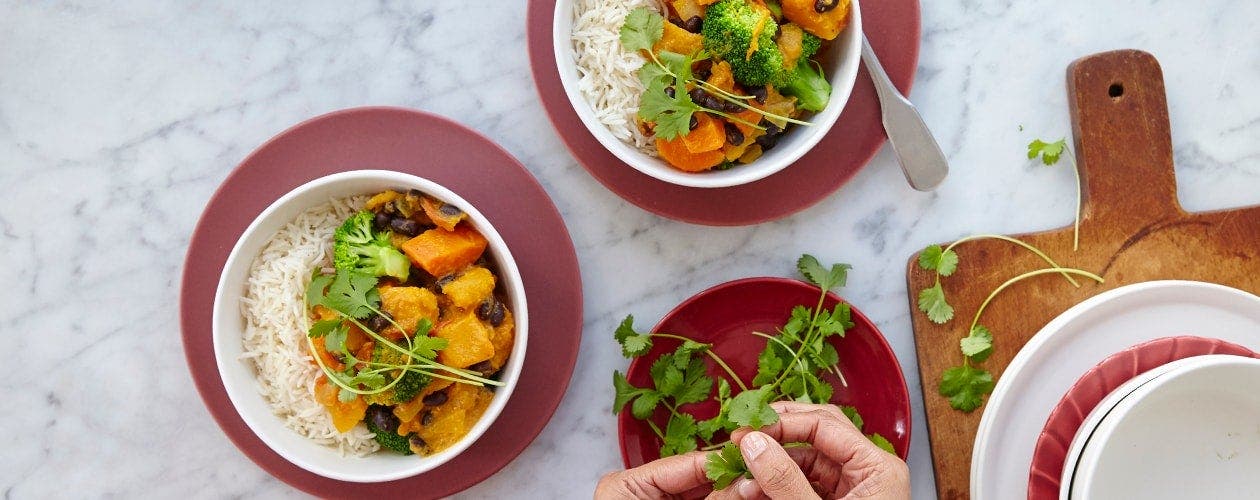Healthy eating and cooking tips to help you lose weight


7 healthy eating habits for weight loss
One of the benefits of joining the WeightWatchers® program is that we support you in discovering how to cook and enjoy healthier meals that suit your individual lifestyle. This can help you to develop eating habits that will stay with you long after you reach your weight loss goals. In fact, after a few weeks, you may find you naturally gravitate towards healthier food choices.
1. Cook at home
The more meals you cook at home, the more control you have over the portion sizes and the ingredients. Not a confident cook? Ask fellow members in the WW Connect community for some tips! WW has loads of easy recipes designed for beginner cooks.
2. Be adventurous with eating
Be open to eating fresh ingredients that you may not normally put in your trolley. Pick up that unusual vegetable or if you haven't eaten something since you were a child, try it again – you never know, you may like it! An easy way to do this is to cook one new recipe a week. If you enjoy it, add it to your regular meals. If you don't, move on and try a new one next week. Trying new things makes meal times more exciting and keeps you motivated.
3. Eat more wholefoods
Wholefoods are foods that are as close to nature as possible (think fresh fruit and vegetables; fresh meat, chicken and seafood; fresh milk; legumes; and wholegrains such as brown rice and barley). They can be better for your health because they often take longer to digest (so you feel fuller for longer). Wholefoods also offer more nutrients and fibre so you get more health benefits in every bite. On the other hand, processed foods (think white bread, deli meats, bottled sauces and most things in packets) often contain hidden fat, salt and added sugar and may offer comparatively lower nutritional value.
4. Weigh or measure ingredients
For some recipes (such as baking) it's essential as you need correct measurements in order for the recipe to be a success. So get yourself some electronic scales, a set of Australian standard measuring cups (for dry ingredients such as rice and flour), a set of Australian standard measuring spoons (where 1 tablespoon equals 20ml) and some metric measuring jugs (for liquid ingredients) and you're ready to go!
5. Plan ahead
Many of our successful members plan almost everything – from the recipes they are going to cook and eat that week to the meal they will order at the restaurant on Friday night (hot tip is to Google the menu). They also don't leave home without a healthy snack, so when hunger strikes they aren't tempted by the vending machine or cafe. Of course, WW is all about flexibility and choice so if you don't want to plan everything that goes in your mouth you don't have to. However, planning some of your meals will help you make healthier choices.
6. Eat fruit and vegetables
Fruit and vegetables are a great to reach for when you're feeling peckish or you want to bulk up your meal. There are so many different types that you'll never get bored and you'll also gain the nutrition benefits of a diet rich in plant foods. Adopt the habit of filling half your plate with non-starchy vegetables and choose two serves of fruit to enjoy throughout the day. Mix things up as much as you can as different plant foods have different health-boosting nutrients. Colour is a great indicator of this, so try to eat a 'rainbow' of different fruit and vegetables each day.
7. Cut yourself some slack
WW doesn't do 'rules' so that means you can't break any. The WW program will gently guide you towards healthier choices but what, when and how you eat remains totally up to you. So if you choose to have that late-night chip session, you can factor it onto you budget and remember that tomorrow is a new day.
Our top healthy cooking tips
- Choose lean cuts of meat and trim off all the visible fat and remove the skin from poultry.
- Use non-stick pans for cooking (a quick spritz of oil spray or 1–2 teaspoons liquid oil is usually enough to stop food from sticking). If cooking pieces of meat, such as steaks or cutlets, brush the meat with oil rather than the pan.
- Use olive, canola or sunflower oil for most cooking needs – they contain healthy fats-mono and poly unsaturated.
- Include flaxseed oil in dressings for extra omega-3 fatty acids (for good health).
- If stir-fried vegetables are sticking to the wok, add a little water or reduced-salt stock instead of more oil. This will create steam to cook the vegetables faster without burning them.
- Line baking trays and cake tins with baking paper. Again, this reduces the amount of oil needed for greasing and also makes washing up a breeze!
- Try alternate sweeteners designed for baking (such as granulated stevia or xylitol) instead of sugar in cakes, muffins, slices and biscuits.
- Swap butter for a reduced-fat spread in baking. In many cakes and muffins, you can also substitute half the spread for no-added-sugar apple puree or mashed banana (this keeps the texture moist with less fat).
- Use a steamer or microwave to cook vegetables as it retains more nutrients. Choose reduced-salt and no-added-sugar products whenever you can.
